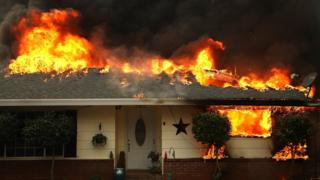Is Trump right about California wildfires?
President Trump has been pointing the finger at the way California manages its forests as the reason for the deadly wildfires that have swept across the state.
During a recent visit, he held up the example of Finland as a country that spends time “raking and cleaning” its forests to reduce the risk of fires.
He had already suggested that California was not managing its forests properly – despite receiving “billions of dollars” each year.
The California Professional Firefighters said the assertion forest management policy was to blame was “dangerously wrong”.
The International Federation of Firefighters – which represents members across the US and Canada – attacked President Trump for suggesting he might cut off funding.
Some of those fighting the recent fires have also pointed out that fires have started in open scrub or grassland rather than in forests.
The comments have also been criticised by some experts who say they ignore the bigger picture of climate change and population shifts in the state.
What is the situation in Finland?
Finland has large forested areas – but Finns were not quite sure what President Trump was referring to when he talked about them “raking”.
Prof Pekka Leskinen, of the European Forest Institute, told BBC News it could have been a misunderstanding during President Trump’s conversation with his Finnish counterpart.
He says there are important differences between forests in Finland and those in California:
Finland also benefits from a network of volunteers who make up an effective early warning system, thus enabling fires to be doused before they spread.
Who manages California’s forest?
In California, nearly 60% of forested areas are managed by national agencies such as the US Forest Service, the Bureau of Land Management and the National Park Service.
And there’s a significant amount in private hands as well.
The actual amount managed by the California state authorities is small – but the California Department of Fire and Forestry Protection is responsible for putting out fires and prevention measures in privately owned areas.
The national agencies have funds set aside for managing the land they own:
We don’t know exactly what amounts are spent on measures to reduce fire risk on land they manage in California.
But concerns have been voiced about whether there’s been enough emphasis on longer-term fire prevention.
Scott Stephens, a leading authority on wildfires at the University of California, has for some years been questioning forest management priorities.
He believes more focus needs to be put on more sensible management of the environment and better land use to avoid “catastrophic burning”.
He has also pointed to the large number of dead trees in parts of the state, due to drought and disease, as a serious fire risk that needs to be addressed.
Tom Bonnicksen, professor of forest science at Texas A&M University, says the real issue is that there are too many trees in California’s forests.
How could forests be managed differently?
Prof Stefan Doerr, at Swansea University, says the modern policy of putting out all fires in wild areas may have been misguided.
For centuries, Native American peoples would burn parts of the forest so they could hunt or gather plants that grow in the cleared areas and that would thin out the more flammable vegetation and make forests less dense.
“But in the recent century or so, the emphasis has been on putting out any fires – and with climate change this has now created a tinderbox of vegetation,” Prof Doerr told BBC News.
The case for allowing controlled fires to clear out vegetation also applies to other types of landscape such grass and shrub land, according to another expert.
Is the problem getting worse?
There’s little doubt fires have been getting worse in California in recent years, both in terms of their destructive power and their size.
All but one of the 10 biggest fires by area have taken place in the past two decades, according to the California Fire Service.
And in terms of loss of life and damage to property, the data shows the worst fires have all been in the past 10 years or so – except for one fire in 1991 in Alameda County.
Many experts point out that climate change has made things worse, leading to higher temperatures, lower humidity and changes in wind and rainfall patterns.
Drier, warmer conditions lead to vegetation drying out and becoming more flammable,.
Add to that the fact that winter seasons when it rains or snows are getting shorter.
California is also one of a number of US states where more and more people are moving out of the main urban centres and into rural or semi-rural areas.
A report by the US Department of Agriculture in 2010 noted that by that year more than 11 million people out of a population of some 37 million in California were living in such areas – and flagged the fire risks this posed.
Also, houses are often built of combustible materials such as wood.
California state law does require homeowners to take steps to protect their properties from fire hazards, including clearing or reducing vegetation near properties.
However, research by the Hoover Institute earlier this year raised concerns over public awareness, enforcement and the availability of up-to-date information about the areas at most risk.
There’s little doubt that unless some of these issues are addressed, the costs to California – as well as to Washington – will grow.
Read more from Reality Check
Send us your questions
Follow us on Twitter
Source: Read Full Article



